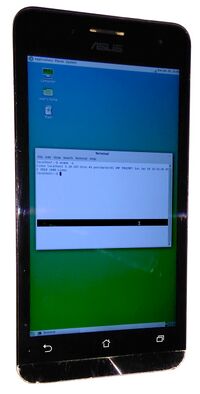Asus Zenfone 5 (asus-t00f)
Appearance
 Asus Zenfone 5 running mate-terminal. | |
| Manufacturer | ASUS |
|---|---|
| Name | Zenfone 5 |
| Codename | t00f, t00j |
| Released | 2014 |
| Hardware | |
| Chipset | Intel Atom Z2580 / Intel Atom Z2560 |
| CPU | Dual-core 2.0 GHz / Dual-core 1.6 GHz |
| GPU | PowerVR SGX544MP2 |
| Display | 720x1280 5" IPS |
| Storage | 8/16/32 GB |
| Memory | 2 GB |
| Software | |
| Original software | Android 4.3 , upgradable to 5.0.2 |
| postmarketOS | |
| Category | testing |
| Pre-built images | no |
| Mainline | no |
| Flashing |
No data |
|---|---|
| USB Networking |
No data |
| Internal storage |
No data |
| SD card |
No data |
| Battery |
No data |
| Screen |
No data |
| Touchscreen |
No data |
| Multimedia | |
| 3D Acceleration |
No data |
| Audio |
No data |
| Camera |
No data |
| Camera Flash |
No data |
| Connectivity | |
| WiFi |
No data |
| Bluetooth |
No data |
| GPS |
No data |
| NFC |
No data |
| Modem | |
| Calls |
No data |
| SMS |
No data |
| Mobile data |
No data |
| Miscellaneous | |
| FDE |
No data |
| USB OTG |
No data |
| HDMI/DP |
No data |
| Sensors | |
| Accelerometer |
No data |
| Magnetometer |
No data |
| Ambient Light |
No data |
| Proximity |
No data |
| Hall Effect |
No data |
| Haptics |
No data |
| Barometer |
No data |
Contributors
yxist
What works
- Installing manually to SD card
- Kernel compilation (LineageOS unofficial)
- Initramfs boot
- USB Network
- Framebuffer graphics (Splash screens)
- SSH Connectivity
- Touchscreen
What does not work
- Flashing using
pmbootstrap flasher - Sensors
- GPS
- Wayland
- Wifi
- Audio playback
- Probably everything else
How to enter flash mode
Hold power button and volume up while device is turned off
Installation
Zenfone 5 uses non-standard bootimg format, so we'll need to create it manually. You'll need a working Zenfone 5 boot.img to proceed.
$ pmbootstrap install --sdcard=/dev/sd?
$ pmbootstrap export
$ git clone https://github.com/shakalaca/ZenFone-boot-tools
$ cd ZenFone-boot-tools
$ make
$ ./pack_intel ./path/to/original/boot.img /tmp/postmarketOS-export/vmlinuz-asus-t00f /tmp/postmarketOS-export/initramfs-asus-t00f output_boot.img
Then you can flash output_boot.img as you normally would using fastboot.
$ sudo fastboot flash boot output_boot.img
See also
- #1176 Initial pull request